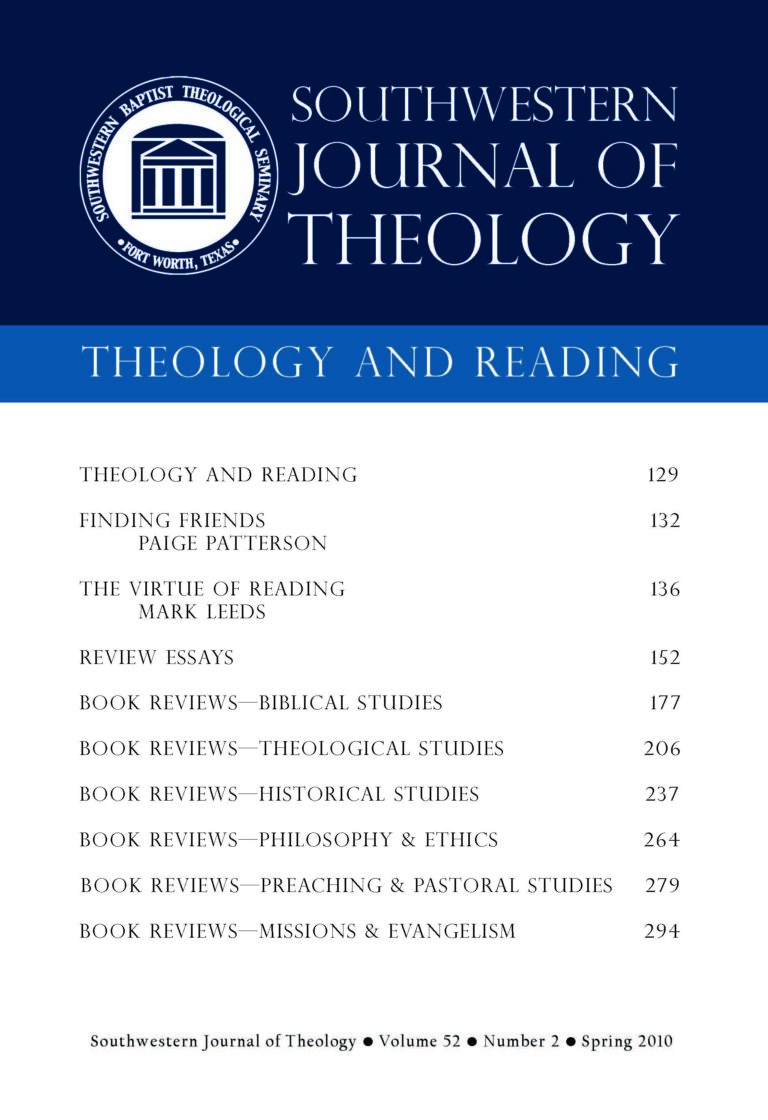
Theology and Reading
Southwestern Journal of Theology
Volume 52, No. 2 – Spring 2010
Managing Editor: Malcolm B. Yarnell III
Edited by Susan Ashbrook Harvey and David G. Hunter. New York: Oxford University Press, 2008, 1020+ xxvii pages. Hardcover, $130.73.
This work is a product of interdisciplinary efforts to represent the formation of early Christianity. Unlike Encyclopedia of Early Christianity (1997), edited by Everett Ferguson, this handbook does not arrange its articles according to the alphabetical order of their titles. Rather, it has eight thematic sections— “Prolegomena,” “Evidence: Material and Textual,” “Identities,” “Regions,” “Structures and Authorities,” “Expressions of Christian Culture,” “Ritual, Piety, and Practice,” and “Theological Themes.” Each thematic section contains several articles pertaining to that specific theme. Therefore, the editors advise their readers to use the indexes to find information on a certain figure or specific term. Each essay has an annotated list of suggested readings and an exhaustive bibliography for further study. In comparison to Encyclopedia of Early Christianity, the Oxford Handbook provides the findings of very recent scholarship on a given subject. In particular, the last chapter of this volume, called “Instrumenta Studiorum: Tools of the Trade,” supplies valuable bibliographical information on critical editions of each major theologian’s works, reliable translations, study societies, and more—the sort of information that is critical to a successful research project. Furthermore, Instrumenta Studiorum presents professional web-sites on early Christianity that one can utilize in his or her well-researched article.
Although the Oxford Handbook offers some theological articles, its primary concern, unlike other patristic handbooks or dictionaries, is not to present the historical development of patristic orthodoxy, which, according to the editors, is mainly the story of male church leaders. Instead, the editors and contributors attempt to present the spiritual, social, and cultural frameworks in which early Christians lived. As Elizabeth A. Clark addresses in her introductory essay, the study of early Christianity “leapt from a theological to a social-historical orientation in the 1970s and 1980s” and has adopted many social science tools such as post-colonial reading and ideology criticism. In this setting, a traditional approach to patristics, which has focused mainly on the theological formulation of early Christianity, is no longer valid to the study of early Christianity.
Therefore, the Oxford Handbook might not be the first choice for that researcher who expects to deepen his understanding of an orthodox father’s theology. There is no section on Athanasius or Augustine although it has fine sections on their counter-theologians, Arius and Pelagius. For a brief survey of a certain doctrine or doctrinal development, J.N.D. Kelly’s Early Christian Doctrine would be the best source. If one needs a more detailed analysis of theological movements in early Christianity, Volume 1 of Justo L. González’s A History of Christian Thought would provide substantial information. For a biographical study of a patristic figure with some theological exegesis of that father’s works, Ferguson’s Encyclopedia of Early Christianity is still the most appropriate source.
Nonetheless, with this recent handbook, Oxford University Press has made another great contribution to the study of early Christianity. This work also provides excellent research materials on the issues with which other patristic or early Christian dictionaries generally do not deal—epigraphy, poetry and hymnography, and homiletics in early Christianity. As a matter of fact, Christianity is not merely about doctrines. The study of early Christianity must embrace its doctrines, cultural contexts, and practices. In addition, this Oxford production will be a great benefit to those who are concerned about a sound methodology in the study of early Christianity that could explain a religious phenomenon from diverse but interrelated perspectives.
Another beauty of this communal work is the editors’ fairness in allowing minor Christian sects or bodies to voice their own identities distinctive from the mainline Latin or Greek Churches. This one volume work might not be useful as a textbook for a graduate-level survey class on early Christianity but would be an indispensible reference source for serious students and scholars.





